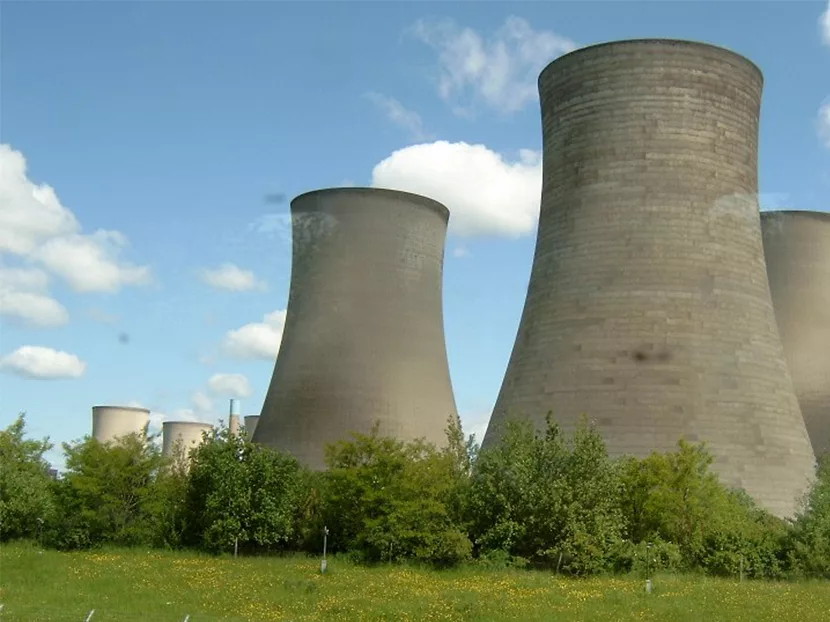As of 2010, there was 81 billion square feet of commercial space in the U.S., about 60 percent of it utilizing cooling towers. That figure doesn’t count the industrial (commercial and manufacturing) and residential (apartment buildings such as high rises) applications that utilize cooling towers to assist chillers and water source air conditioners in air-conditioning their respective buildings.
What makes cooling towers attractive is that they can cool down condenser water typically below the dry-bulb temperature through the process of evaporative cooling. On a 100 F day, depending on the relative humidity, a cooling tower may be able to reduce the condenser water temperature another 10 to 15 degrees (or more). This can save a tremendous amount of electrical energy, and also keeps the cooling capacity higher than direct exchange (straight air-source, or dry cooler) would provide.
However, cooling towers have several draw-backs. Among them are:
- High potable water consumption
- Storm susceptibility (outside equipment)
- Public health risk (Legionnaire’s disease)
- Takes up space
- Short longevity (10 to 15 years)
- Rather noisy
Why point out the draw-backs unless there’s an alternative? Actually, there is an alternative: geothermal sourced cooling (and heating).
Geothermal sourced cooling provides improved energy efficiency, and perhaps more importantly, eliminates each and every one of the draw-backs noted above. It’s hard to say which of the alternatives is most important, but water conservation and a couple of the others are worth a mention here.
The U.S. could save at least 2 trillion gallons of water each year by converting to geothermal, not to mention the incalculable combustion heating and resulting CO2 emissions that would be eliminated. That’s enough water savings for the household needs of every person in California AND Georgia for an entire year. Another way to look at 2 trillion gallons is in a swimming pool scenario. A 2 trillion gallon swimming pool, 5 feet deep, would need to be 1 mile wide by 2000 miles long.
Cooling towers in commercial buildings are the number two consumer of potable water, using more water than landscape irrigation or the office cafeteria/kitchen facilities. Only the restrooms use more water (national average) than cooling towers in commercial buildings.
In Tennessee, the Nashville Airport is in the process of going 100 percent geothermal. They will no longer need their cooling towers or boilers. Universities and schools all over the country are going geothermal. In New York City, a new law will require all city-owned buildings to go geothermal when upgrading or building new as of 2017. They need only to show a payback in less than 20 years. How much would you like to bet they all fit that category? Save your money; they are all going to be geothermal.
Geothermal sources can be coupled to geothermal heat pumps (GHPs), chillers, reversing chillers, swimming pool heat pumps, ice rinks and just about any other device that might need cooling or heating. Geothermal loops are an abundant source for heating and a super-efficient repository for heat-sinking (as in cooling; rejecting heat).
Speaking of hydronics, geothermal adds unprecedented benefits and possibilities. Moving beyond the scale of single buildings, think of a city blocks, or a “grid” as it’s sometimes referred to. In the winter the residential apartments are going to need heat at the same time as the commercial buildings are rejecting heat (commercial buildings are often nearly 100 percent cooling dominant due to internal gains). Instead of those commercial buildings rejecting heat to the outdoors through the cooling towers, that heat is now confined in a geothermal pipeline, easily distributed to the heat-hungry GHPs serving the residential apartments; energy synergy at its best.
As we can see from the items covered, there are several other advantages to cooling tower elimination beyond water and energy savings.
Elimination of combustion heating and the resulting CO2 emissions are a hot topic right now, and geothermal is the only reasonable heating source that eliminates combustion. It’s only a matter of time until we will all be doing it, so let’s beat the learning curve and get involved now with geothermal industry organizations, GEO and IGSHPA.






